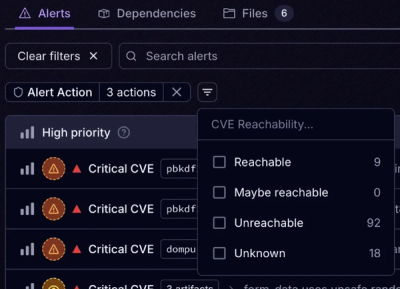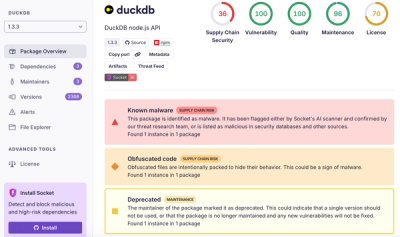
Product
Introducing Tier 1 Reachability: Precision CVE Triage for Enterprise Teams
Socket’s new Tier 1 Reachability filters out up to 80% of irrelevant CVEs, so security teams can focus on the vulnerabilities that matter.
create-locator
Advanced tools
The create-locator 📌 library allows you to mark HTML elements with locators and
find these elements by their locators in tests.
Marking an HTML element with a locator in the application code looks like this (example in JSX):
export const Foo = () => {
return <div {...locator('foo')}>Hello👋 world!</div>;
};
In the browser, this element will render into the following DOM structure:
<div data-testid="foo">Hello👋 world!</div>
In tests you can use locators in this way (example in Playwright):
await locator('foo').click();
npm install create-locator
The first argument of the locator function is called the locator's testId.
Typically, it’s a unique string that allows you to find the element marked by the locator in tests.
The locator can also have an optional set of arbitrary parameters (only the line with the locator is shown):
<div {...locator('foo', {bar: 'baz'})}>
This element with the locator will render into the following DOM structure:
<div data-testid="foo" data-test-bar="baz">
The values of the parameters can also be numbers and boolean values:
<div {...locator('foo', {bar: true, baz: 12})}>
This will render as:
<div data-testid="foo" data-test-bar="true" data-test-baz="12">
Parameters with null and undefined values will be omitted:
<div {...locator('foo', {bar: null, baz: undefined, qux: false})}>
This will render as:
<div data-testid="foo" data-test-qux="false">
The testId of the locator can consist of multiple parts, including numbers and boolean values:
<div {...locator('foo', 'qux', 3)}>
This will render as:
<div data-testid="foo-qux-3">
An object with parameters can also follow several parts of the testId:
<div {...locator('foo', 'qux', 3, {bar: true, baz: 12})}>
This will render as:
<div data-testid="foo-qux-3" data-test-bar="true" data-test-baz="12">
The ability to specify a testId composed of multiple parts is useful for dynamic components,
which can accept an optional testId string property in their props:
type Properties = {testId?: string};
export const Button = ({testId}: Properties) => (
<label {...locator(testId, 'label')}>
<button {...locator(testId, 'button')}>{/* ... */}</button>
</label>
);
For example, with testId="submitButton", this will render into the following DOM structure:
<label data-testid="submitButton-label">
<button data-testid="submitButton-button">{/* ... */}</button>
</label>
To create locator function, first define the attributes options in a separate file
(since you will import them in both your application code and your test code):
// app/attributesOptions.ts
import type {AttributesOptions} from 'create-locator';
export const attributesOptions: AttributesOptions = {
parameterAttributePrefix: 'data-test-',
testIdAttribute: 'data-testid',
testIdSeparator: '-',
};
Then create locator function and additional getTestId function in application code using these options
and the boolean parameter isProduction (if isProduction is true, no one locator attributes are rendered):
// app/locator.ts
import {createSimpleLocator} from 'create-locator';
import {attributesOptions} from './attributesOptions';
const isProduction: boolean = /* ... */;
export const {locator, getTestId} = createSimpleLocator({attributesOptions, isProduction});
In test code, create locator function and additional getSelector and getTestId functions in a similar manner
(using the example of the Playwright,
where getPage is the function of getting the current Playwright page):
// tests/locator.ts
import {createTestLocator} from 'create-locator';
import {attributesOptions} from '../app/attributesOptions';
import {getPage} from './getPage';
export const {locator, getSelector, getTestId} = createTestLocator({
attributesOptions,
createLocatorByCssSelector: (selector) => getPage().locator(selector),
supportWildcardsInCssSelectors: true,
});
FAQs
Creates HTML element locators for tests 📌
We found that create-locator demonstrated a healthy version release cadence and project activity because the last version was released less than a year ago. It has 1 open source maintainer collaborating on the project.
Did you know?

Socket for GitHub automatically highlights issues in each pull request and monitors the health of all your open source dependencies. Discover the contents of your packages and block harmful activity before you install or update your dependencies.

Product
Socket’s new Tier 1 Reachability filters out up to 80% of irrelevant CVEs, so security teams can focus on the vulnerabilities that matter.

Research
/Security News
Ongoing npm supply chain attack spreads to DuckDB: multiple packages compromised with the same wallet-drainer malware.

Security News
The MCP Steering Committee has launched the official MCP Registry in preview, a central hub for discovering and publishing MCP servers.